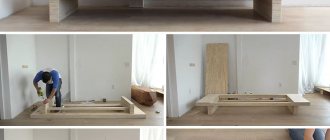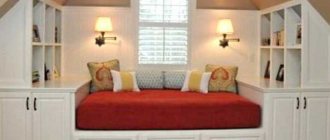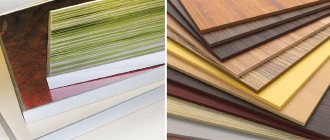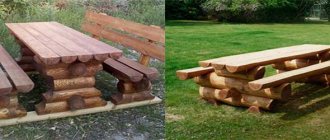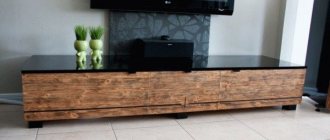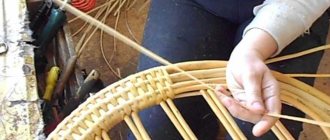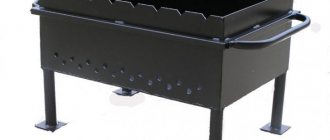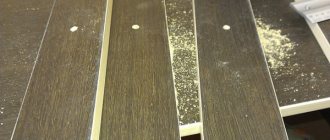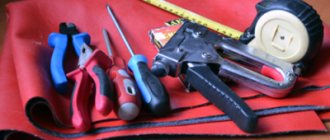0
40743
Using solid wood in the manufacture of furniture or interior items can be quite expensive. An alternative in the form of furniture panels significantly reduces the cost of production, despite the fact that the product will be based on environmentally friendly, high-quality raw materials. An element such as a furniture panel has different sizes, depending on the production method, so choosing the material suitable for your purposes is not difficult. This type of material is used for the manufacture of decorative interior parts, door panels, window sills, countertops, stairs, garden furniture, cabinet and modular. For furniture panels, GOST standards for processing wood raw materials are applied. Furniture board can be considered a composite material, similar to plywood or chipboard, provided that the latter were made from valuable wood species. The structure and properties of the product are very multifaceted. The most popular products on the market are products based on pine, spruce, oak, ash, and birch.
What is
Not all craftsmen know exactly what a furniture panel is. This is a material in the form of sheets based on wood. It is obtained by gluing timber together. The production technology includes the following stages:
- lumber is dried;
- defects are removed;
- trimming occurs in accordance with the desired dimensions;
- the blanks are spliced together;
- the slats are calibrated;
- the shield is glued together.
This material has many advantages. Firstly, furniture of the largest sizes can be made from it (a monolithic array is used for this purpose). Secondly, a well-glued shield does not deform over time. Finally, thirdly, thanks to deep processing, the cost of production becomes significantly lower.
Sometimes non-professionals mistakenly refer to ordinary laminated sheets of fine fraction as MDF furniture board. However, these two types of products cannot be classified into the same category. They are made from different raw materials, and manufacturing techniques also differ.
The shield is made from timber, and MDF sheets are made from wood fibers. The first type of material is produced by gluing the components, and the second by compressing them under high pressure. In addition, MDF has a shorter service life.
Furniture board production technology
Main advantages
Furniture board is one of the most affordable materials for craftsmen and amateur carpenters. You can purchase sheets of different sizes at any construction department. The product has many advantages compared to MDF, chipboard, fiberboard:
- durability;
- sustainability;
- possibility of repair;
- practicality.
The variety of shapes and colors of sheets makes it easy to decorate any interior, spending a minimum of money, time, and effort. It is not necessary to putty the surface of furniture made from this material; you can only treat it with colorless wood varnish. Due to the absence of internal stress, the wooden panel does not warp or crack over time. The panels are also highly resistant to moisture and do not suffer from fungus and mold; Veneered sheets last especially long. Production technology allows you to include additional materials in the composition. Most often these are inclusions of marble, granite or plastic of various colors and shades.
This material is considered natural. Unlike chipboard, it does not emit harmful substances, so we can safely recommend wooden panels for the manufacture of children's furniture - tables, chairs, cribs for newborns. Prolonged contact with the sheets does not cause allergic reactions, and there is no unpleasant odor from them. During production, aggressive chemicals are not used to process raw materials.
Scope of application of furniture screws, installation features
The main aesthetic advantage of the product is the interesting pattern on the surface of each sheet. Its specificity depends on what kind of wood was used as raw material. The most beautiful are products made from alder, birch and oak. They are often used to make designer luxury furniture. The needles also look impressive.
Professional designers claim that furniture made from panels has the unique ability to fit into the interior of any style. Wenge-colored material looks most impressive in modern city apartments and private houses.
Durability
Sustainability
Possibility of repair
Practicality
Types of gluing and categories
Furniture panels are divided into two types depending on the method of gluing the components - solid (made of solid wood) and made of fabric lamellas connected to each other. The spliced version may consist of one or more layers and have an open or closed microspike. For production, monolithic lamellas or parts from several components are used.
Types of accessories for upholstered furniture, functionality and characteristics
The standard classification involves division into varieties, each of which is assigned a letter of the Latin alphabet. Whether a panel belongs to one category or another depends on the quality of the product: the presence or absence of defects, knots, cracks and other signs of deformation.
| Category | Key Features |
| A | Completely clean surface, a few small live knots, no warping |
| B | Sapwood is acceptable; the knots may be dark; it is not sorted by color or shade. One side is the front side, the other is the back side. Can be covered with veneer |
| C | There is no selection for painting and sawing. The presence of a large number of living knots up to 3 mm, sharp color transitions |
Also, manufacturers of laminated boards often use a different classification. According to it, all products are divided into three categories - extra, A, AB. In this case, the first group includes exclusively products made from monolithic lamella fabric, the second group includes wooden products without knots, and the third group includes finger-jointed panels used as blanks for veneer covering.
| Group | What standard categories does it correspond to? |
| Extra | A |
| A | B |
| AB | C |
The most expensive panels usually belong to category A (extra). They undergo multi-stage quality control and strict sorting. Any defect is removed from production. A glued board costs less than a monolithic one.
Furniture panels depending on the gluing method
Division into categories depending on the quality of the product
Categories of furniture panels
Oak
General characteristics of oak furniture panels:
- packaging - shrink film;
- humidity - 8-10%;
- weight of a dense cube - 650-720 kg;
- execution - spliced/solid-lamella;
- processing - polished surface, abrasive grain size - 100-120;
- adhesive connection class - D3;
- lamella width - 35-50 mm;
- Brinell hardness - 3.8;
- tolerances on geometric dimensions - width ±2 mm/length ±2 mm/thickness ±0.2 mm;
- size range - length 1000-3000 mm/width 200-1000 mm.
| Furniture Panel Oak Extra - thickness 20/22 mm | ||||
| Thickness, mm | Length, mm | Width, mm | Execution | price, rub. |
| 20 | 1000 | 600 | solid-lamella | 3 120 |
| 1000 | 800 | 4 160 | ||
| 1200 | 600 | 3 744 | ||
| 1200 | 800 | 4 992 | ||
| 1300 | 400 | 2 704 | ||
| 1300 | 600 | 4 056 | ||
| 1400 | 800 | 5 824 | ||
| 1500 | 400 | 3 120 | ||
| 1500 | 600 | 4 680 | ||
| 1500 | 800 | 6 240 | ||
| 1600 | 600 | 4 992 | ||
| 1800 | 400 | 3 744 | ||
| 1800 | 600 | 5 616 | ||
| 2000 | 600 | 6 240 | ||
| 2200 | 600 | 6 864 | ||
| 2500 | 600 | 7 800 | ||
| 2700 | 600 | 8 910 | ||
| 2800 | 600 | 9 240 | ||
| 2900 | 400 | 6 380 | ||
| 2900 | 600 | 9 570 | ||
| 2900 | 620 | 9 889 | ||
| 3000 | 600 | 9 900 | ||
| 1500 | 800 | spliced | 3 480 | |
| 2000 | 400 | 2 320 | ||
| 2000 | 600 | 3 480 | ||
| 2000 | 620 | 3 596 | ||
| 2000 | 800 | 4 640 | ||
| 2500 | 400 | 2 900 | ||
| 3000 | 400 | 3 480 | ||
| 3000 | 600 | 5 220 | ||
| 3500 | 600 | 6 090 | ||
| 3500 | 800 | 8 120 | ||
| 22 | 3000 | 1200 | spliced | 10 440 |
| Furniture Panel Oak Natur jointed - thickness 20-25 mm | |||
| Thickness, mm | Length, mm | Width, mm | price, rub. |
| 20 | 2000 | 400 | 2 240 |
| 2500 | 200 | 1 400 | |
| 2500 | 400 | 2 800 | |
| 2500 | 600 | 4 200 | |
| 25 | 2000 | 400 | 2 400 |
| 2000 | 600 | 3 600 | |
| 2500 | 400 | 3 000 | |
| 2500 | 600 | 4 500 | |
| 2500 | 800 | 6 000 | |
| 3000 | 400 | 3 600 | |
| 3000 | 600 | 5 400 | |
| 3000 | 800 | 7 200 | |
| Furniture Panel Oak Extra solid - thickness 40 mm | |||
| Thickness, mm | Length, mm | Width, mm | price, rub. |
| 40 | 900 | 300 | 2 025 |
| 1000 | 1000 | 10 000 | |
| 1200 | 600 | 6 336 | |
| 1300 | 400 | 4 576 | |
| 1500 | 400 | 5 580 | |
| 1500 | 600 | 8 370 | |
| 1600 | 600 | 8 928 | |
| 1600 | 800 | 11 904 | |
| 1800 | 600 | 10 044 | |
| 1800 | 800 | 13 392 | |
| 2000 | 400 | 7 440 | |
| 2000 | 600 | 11 160 | |
| 2000 | 620 | 11 532 | |
| 2000 | 800 | 14 880 | |
| 2000 | 1000 | 20 000 | |
| 2100 | 600 | 11 718 | |
| 2300 | 600 | 12 834 | |
| 2500 | 600 | 13 950 | |
| 2500 | 800 | 18 600 | |
| 2600 | 400 | 10 192 | |
| 2700 | 400 | 10 584 | |
| 2800 | 600 | 16 464 | |
| 3000 | 400 | 11 760 | |
| 3000 | 600 | 17 640 | |
| Furniture Panel Oak Extra finger-jointed - thickness 40 mm | |||
| Thickness, mm | Length, mm | Width, mm | price, rub. |
| 40 | 2500 | 600 | 9 000 |
| 2500 | 800 | 12 000 | |
| 2500 | 1000 | 15 000 | |
| 3000 | 600 | 10 800 | |
| 3000 | 800 | 14 400 | |
| 4000 | 600 | 14 400 | |
| Glued laminated timber Extra Oak | |||||
| Thickness, mm | Width, mm | Length, mm | Execution | Photo | price, rub. |
| 100 | 100 | 3000 | spliced | 4 500 | |
Size options
Sheets come in different sizes. Minimum length – 50, maximum – 100 mm; the largest dimensions are 5000 x 1200 mm. The following modifications are also possible:
- 500 x 1000;
- 400 x 600;
- 250 x 600;
- 200 x 600.
The thickness also varies. The minimum (16 mm) is used in the production of tabletops, facades, and individual parts of cabinet furniture. Standard (19 mm) can also be used to make headboards for children's and adult beds. Luxury class (35 mm) is usually used for armrests, seats, supporting parts of prefabricated structures; This is, as a rule, a furniture panel made of solid wood.
Thickness is the most important parameter. The cost of the panel largely depends on it. For example, if you make a hanging shelf from the thinnest slab, it can quickly bend and become deformed under the weight of things. This must be kept in mind when calculating the reliability of the structure.
To manufacture products based on designer's original projects, a solid-lamella furniture panel of non-standard dimensions is sometimes required. These options are made to order. The smallest panels are used for the production of individual decorative elements (for example, carvings), the largest ones are used for the production of built-in structures. The main advantage of the latter is its spectacular appearance due to the complete absence of seams.
The dimensions of non-standard panels depend on the production capabilities of a particular enterprise and on the specifics of the equipment used. As a rule, small woodworking factories do not undertake their production, because it is not economically profitable.
According to the latest marketing research on the building materials market, furniture panels made of coniferous wood measuring 800 x 2500 mm are currently most in demand in Russia. They are convenient to work with at home due to their compactness and small dimensions. Usually they are used to make the basis for various types of cabinet furniture in cases where chipboard is not suitable due to the complexity of the design and the large number of threaded connections.
Furniture chipboard panel
In this article we will try to figure out what a furniture panel is? What types of furniture are made from it? And how is it produced?
Furniture board is the material from which furniture is made. It is made by gluing parts of the same wood into one piece. In addition, furniture panels are made from waste wood, which is pressed and glued together. The resulting material is used to create cladding panels and furniture.
The most popular material for the production of cabinet furniture can be called chipboard furniture. Chipboard (chipboard) is most often used by furniture factories in their production. The main advantages of this material are:
- large surface area (standard sizes 260/183 cm)
- low cost compared to solid wood panels
- lack of clearly defined fiber orientation.
During the production process, particle board is very often laminated, resulting in a laminated furniture panel, and also covered with veneer.
Laminated chipboard furniture board
The lamination process consists of gluing film or paper sheets to the surface of the board using resin. The result of this cladding is laminated chipboard. It is perhaps the most accessible material today, which has the widest range of applications. This material is used by all furniture enterprises and furniture manufacturing plants, as well as construction companies, without exception.
Sheets of laminated chipboard are impregnated with melamine resins, which give them strength and resistance to mechanical damage, humidity, and temperature differences. But the most important reason why this material is so widely used is that with the use of furniture panels made of laminated chipboard, further finishing of walls, ceilings or other elements is not just necessary. This quality has allowed the material to become a leader in the construction and furniture markets. Products made from laminated chipboard sheets are almost not exposed to hot objects, therefore they are used in kitchen sets in the form of countertops, because there are no scratches or marks from a kettle or a hot pan on them.
The qualities of the material make it possible to use it in the production of furniture for office premises, because the size and cost of the laminated chipboard sheet allow for a low price to achieve excellent quality office furniture that will last for many years and will not dry out.
It is also worth noting that given the simple processing and wide range of shades and coatings, laminated chipboard is a popular material that is used all over the world. The widest range of colors allows you to achieve a shade that matches any type of wood - experts use laminated chipboard to create a wide variety of interiors, from classics to creative projects.
Available sizes of furniture panels made of chipboard
The largest size of a furniture panel is limited only by the format of the chipboard sheet put into sawing. Most often, this is one of the standard formats, which belongs to the warehouse program and depends on the chosen color and the required thickness: 2750 by 1830 and 2440 by 1830. Dimensions are always given in millimeters.
However, clients of furniture companies order a wide variety of sizes of furniture panels. The most common:
- 800x200, x300, x400, x500
- 1200x200, x300, x400, x500
- 2400x200, x300, x400, x500
Typically, chipboard sheets are thick:
- 28 mm
- 25 mm
- 22 mm
- 19 mm
- 18 mm
- 16 mm
- 12 mm
- 10 mm.
Due to its characteristics, particle boards are widely used in both interior design and manufacturing. For example, in the manufacture of a work surface for the kitchen, which is used to cover kitchen units and appliances. On the resulting common working area, the laminate film (or paper) is wrapped onto the end of the slab from the main surface. The width of such slabs is most often 60 cm, the length is from three to six meters, and the thickness is from 25 to 35 cm. The tabletop itself can have a surface of different textures, which directly depends on the film. For such working surfaces, strips and slats that match the color are selected to hide the gaps.
Chipboards are also used in the construction industry. Cement is used as a gluing compound for bentonite. The ratio of width to length of the resulting slab is 125 to 320 cm, sheet thickness is 10-40 mm. The material is easy to process, has high fire resistance, and therefore is widely used to create partitions.
Dimensions of furniture panels made of laminated chipboard
As a standard, furniture companies produce sheets of 2800 x 2070, with a width of 16, 18, or 22 mm. When choosing, you need to pay attention to such a parameter as the weight of chipboard or laminated chipboard. For example, sanded sheets can weigh from 58.7 kg to 71.4 kg. This weight is optimal; it makes it possible to easily work with the material, and also provides its necessary strength.
Laminated chipboard (LDSP) today is most often used for the manufacture of office and school, kitchen and children's furniture. Well-known companies produce rectangular chipboards, but with different parameters of thickness, length and width of the sheet. Thanks to the huge variety of formats, furniture makers can choose the right size for literally every product to minimize the amount of waste and trimmings. For example, slabs with a thickness of 16 mm and 18 mm are convenient to use for the manufacture of wardrobes and wardrobes. With a thickness of 25 - 30 mm, laminated chipboard sheets will be an excellent material for the manufacture of kitchen table tops and other furniture elements that are subject to high loads. Due to the fact that chipboard is made from natural wood raw materials and contains a minimum amount of formaldehyde, and decorative laminating film is distinguished by a huge variety of shades and textures, this type of material is in deserved demand.
Use in furniture production
In carpentry, panels can be used to make structures out of wood. They are also widely used in the production of interior items. From furniture board you can make:
- tables and chairs;
- chests of drawers;
- shoe racks in the hallway;
- stools;
- children's and adult beds.
Classification of furniture safes, tips for choosing them
Sometimes wooden panels are used to replace plasterboard when finishing walls and ceilings. Door panels and various types of stairs made from this material are very popular. Furniture boards laid as parquet boards look beautiful.
Most often, cabinet furniture in living rooms and hallways is made from maple panels; alder and linden are less popular. The uniqueness of the first material is that it can be used to decorate any type of premises. Due to their increased resistance to moisture and mechanical external influences, products made from sheets of different sizes are well suited for children's rooms, bathrooms and toilets. A variety of colors and shades, as well as patterns on the surface, makes it easy to choose the wood that is most suitable for a specific interior. The products go well with Provence and classic styles, but poorly with hi-tech.
Tables, chairs, stools
Dressers
Shoe racks in the hallway
Beds
Wall decoration
As parquet
Areas of use
Often used for the manufacture of facades, panels, cabinets and countertops. Often, furniture in corridors and living rooms is made from maple-based furniture panels. Can also be used to decorate other rooms, such as a bathroom, toilet, bedroom, children's room, kitchen and dining room. It is also used in carpentry and furniture production. At the same time, the cost of one product can be very varied, but it is definitely not more expensive than a natural solid. The use of such furniture will help complement any interior, regardless of the style used in the design. The most frequent requests come specifically for the wenge shade.
Found my application:
- in the manufacture of built-in structures;
- individual elements that can be used when carrying out interior finishing work;
- door panels;
- various types of stairs;
- window sills;
- parquet board;
- for covering ceilings and walls, instead of drywall;
- in the manufacture of ceiling and wall panels and wooden floor beams.
Life time
If the slabs are well processed, things made from them can last up to a hundred years or more. However, this only applies to monolithic and not jointed panels. Damaged products can be easily updated and restored. In order to extend the shelf life of furniture, you must:
- Protect things made from shields from sudden temperature changes.
- In winter, store furniture intended for a summer cottage (for example, sun loungers or garden benches) indoors.
- Do not overload hanging shelves, cabinets, chests of drawers with a large number of bulky, large items.
- Choose only high quality panels for carpentry and carpentry work at home.
With proper, careful, reasonable treatment of things, they will last a long time, maintaining a spectacular appearance. Unlike chipboard and fibreboard, the board has a denser structure and is practically not subject to deformation. Furniture made from it can be dismantled several times and then reassembled without compromising quality. For this reason, compact panels of a convenient shape and low weight are so valued by craftsmen and amateur carpenters.
This material is also loved for its strength and high aesthetic qualities. Products made in a factory or at home are in no way inferior to wooden products. The main thing is to use the furniture board correctly and store it in proper conditions.
Protect from sudden temperature changes
Store country furniture indoors in winter
Do not overload the furniture with too many things
Choose high quality material
